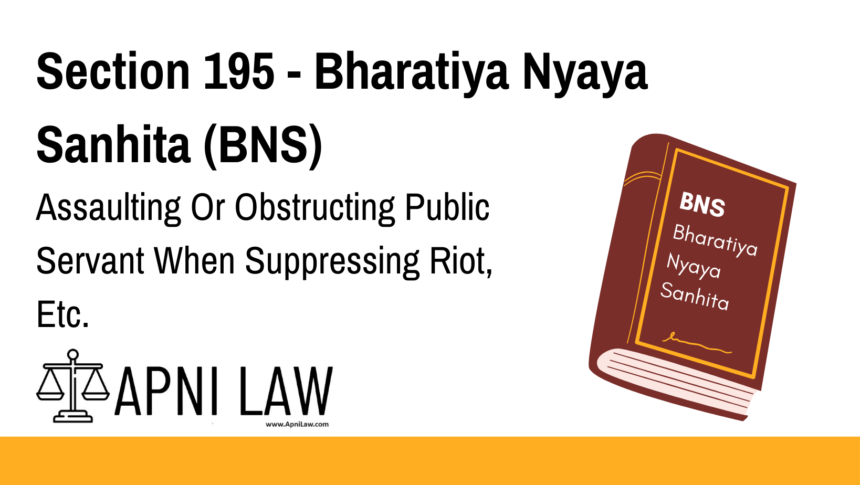Code: Section 195 BNS
(1) Whoever assaults or obstructs any public servant or uses criminal force on
any public servant in the discharge of his duty as such public servant in endeavouring to
disperse an unlawful assembly, or to suppress a riot or affray, shall be punished with
imprisonment of either description for a term which may extend to three years, or with fine
which shall not be less than twenty-five thousand rupees, or with both.
(2) Whoever threatens to assault or attempts to obstruct any public servant or threatens
or attempts to use criminal force to any public servant in the discharge of his duty as such
public servant in endeavouring to disperse an unlawful assembly, or to suppress a riot or
affray, shall be punished with imprisonment of either description for a term which may extend
to one year, or with fine, or with both.
Explanation of Section 195 BNS
Section 195 of the Bharatiya Nyaya Sanhita (BNS), 2023, addresses the offence of assaulting, obstructing, or using criminal force against a public servant who is performing duties related to dispersing an unlawful assembly, suppressing a riot, or controlling an affray.
Key Elements of Section 195 BNS
- Who is protected?
- Public servants performing duties such as:
- Dispersing an unlawful assembly (as per Section 150 BNS).
- Suppressing a riot (as per Section 191 BNS).
- Controlling an affray (as per Section 194 BNS).
- Public servants performing duties such as:
- Types of Offences and Their Punishments:
- Actual assault or obstruction → Up to 3 years imprisonment + ₹25,000 fine (minimum).
- Threats or attempts to obstruct → Up to 1 year imprisonment or fine, or both.
- Use of criminal force – Any physical act intended to cause harm or intimidation against a public servant is punishable.
Illustration of Section 195 BNS
Example 1: Assaulting a Police Officer During a Riot
During a violent protest, a police officer tries to disperse the crowd. An individual throws a stone at the officer, obstructing him from performing his duty. This act is punishable under Section 195(1) BNS.
Example 2: Threatening an Officer Trying to Stop a Fight
A magistrate orders police officers to stop a public brawl. One of the individuals involved threatens to harm the officer if he intervenes. Since this is a verbal threat, it falls under Section 195(2) BNS.
Common Questions and Answers on Section 195 BNS
1. What is the key difference between Section 195(1) and Section 195(2) BNS?
- Answer:
- Section 195(1) applies when actual assault, criminal force, or obstruction occurs.
- Section 195(2) applies when there is only a threat or an attempt to obstruct but no actual assault.
2. What is the minimum fine under Section 195 BNS?
- Answer: The minimum fine for an offence under Section 195(1) BNS is ₹25,000. There is no minimum fine for Section 195(2) BNS.
3. Is Section 195 BNS a cognizable offence?
- Answer: Yes, an offence under Section 195(1) BNS (assault or obstruction) is cognizable, meaning the police can arrest the offender without prior court approval. However, an offence under Section 195(2) BNS (threats or attempts) may be non-cognizable, requiring court permission.
4. Is Section 195 BNS a bailable offence?
- Answer:
- Section 195(1) BNS (assaulting/obstructing a public servant) may be non-bailable, depending on the circumstances.
- Section 195(2) BNS (threatening a public servant) is generally bailable.
5. Does Section 195 BNS apply only to police officers?
- Answer: No, it applies to all public servants involved in dispersing riots, unlawful assemblies, or suppressing affrays, including magistrates, municipal officers, and administrative officials.
Conclusion
Section 195 BNS is crucial in protecting public servants from physical harm, obstruction, and threats while performing their duties. Assaulting a public servant carries strict penalties, including up to 3 years in prison and a fine of ₹25,000. This provision ensures the maintenance of law and order while safeguarding officials from violent resistance.
For more legal insights, visit ApniLaw today! 🚀








